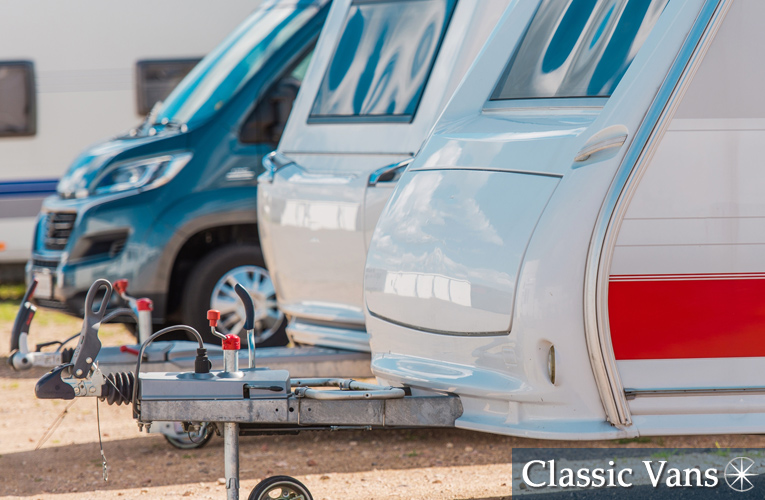
8 best practices for storing your travel vehicle for winter or long-term storage
Many RV, campervan and motorhome owners choose to store their travel vehicle over the winter as they eagerly wait for warmer weather to get back on the road. Appropriate storage of these vehicles must be considered to ensure the longevity of your mobile home.
In some places, cold winters last several months. Therefore, storing your vehicle needs to be done thoughtfully to avoid expensive repairs.
If you’re wondering how to store your RV, campervan or motorhome—from the coach area’s preparation to the vehicle’s maintenance and all its components—then you’ve come to the right place. We will break down the process step-by-step.
Step 1: Empty the vehicle
The first step is ensuring you have emptied all the cupboards and medicine cabinets. Remove all food and liquids, including soaps, toothpaste, lotions and cooking supplies. These items can freeze during the winter, melting later on in the spring and leaving stains that may not easily come out.
Step 2: Clean the interior
Clean the entire coach area thoroughly using antiseptic cleaners to avoid any molds or germs. Remove all the beddings and vacuum all the seats and storage areas, ensuring you’ve left nothing behind. After you’ve removed all the fridge items, do an in-depth deep clean of the fridge and leave its doors open. Also, disconnect the refrigerator from its power source since it’s no longer in use.
Step 3: Wash the exterior
Now that you are done with the coach’s interior, it’s time to prepare the exterior for long-term storage. Clean it and let it dry well. We recommend that you park your RV or motorhome under a covered or indoor area, if possible. Avoid parking it under trees where leaves can fall on it or on the grass where weeds will grow.
Step 4: Flush the plumbing system
Your RV likely also has a water plumbing system that needs to be prepared for winter storage. The water in the plumbing system can freeze up during winter, leading to the dreaded breaking of the water pipes and massive damage to the plumbing system. Remove all the water from the tanks, then fill them with non-toxic antifreeze.
The process of removing the water from the RV’s plumbing system can be tedious and laborious. If you’re not up for the task, we recommend that you have your RV winterized by a local dealer or mobile RV repair service. If you perform the process yourself, make sure you adhere to your RVs manufacturer’s instructions as each manufacturer has different requirements.
Step 5: Disengage the parking brake
We recommend leaving the parking brake off (disengaged). While performing the campervan storage, ensure that as few of its parts are being used as possible, including the parking brake.
Step 6: Prepare the tires
Check the RV’s tires, front and back. Inflate the tires to the recommended pressure by the manufacturer for cold weather storage. Keeping them with less or more than the required pressure will lead to the destruction of the tires throughout the storage period.
After inflating the tires to the required pressure level, protect them with tire covers. The covering of tires is a reasonably new concept, but a game-changing one. Tire specialists have determined that tires degraded more rapidly when not covered due to exposure to the harsh weather conditions causing them to crack and burst.
Another important thing to understand about tires is that regular movement helps prevent flat spots on the tires. Flat spots occur over a long time, especially in cold weather, which makes the tires harden into a flattened shape, which is noticeable while driving. The flat areas will affect the vehicle’s ride quality and significantly shorten the tires’ lifespan.
Ensure when you park your RV for the long-term that you park it on a flat surface and avoid turning the wheels. Leaving the RV with turned wheels for a long time will cause issues with alignment later. When driving, you will find the vehicle veering into the direction in which the wheels were facing, which can be very annoying.
Step 7: Inspect the vehicle for cracks and openings
Finally, carefully inspect the roof and body seams to ensure they are in their designed position. As you do this, make sure all the windows are closed and that their sealants are functioning well to avoid cracks and openings that can let water into the RV.
Step 8: Put on the cover
If you are able to purchase a cover for your RV, it’s worth the investment. It might seem like an expensive item upfront, but protecting your rig from wear and tear is worth the expense in the long-run. Without the cover, the RV’s paint job can deteriorate when sitting in the sun for a long period of time, not to mention the rust that can accumulate on its hinges. The cover is worth it since it can be used for several years, protecting your RV during all seasons.
Your motorhome storage is now complete and ready for winter! All you need to do now is to start planning your next adventure route.